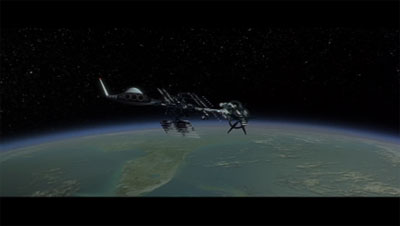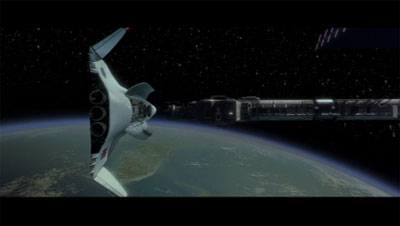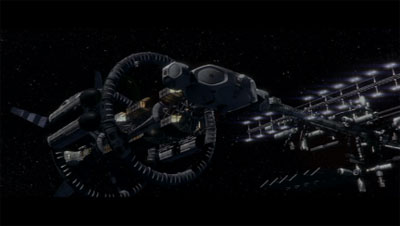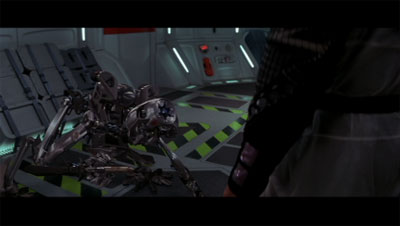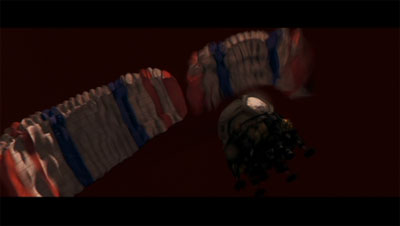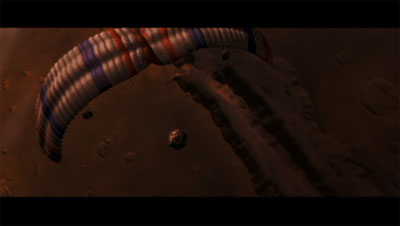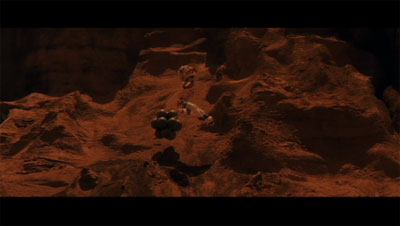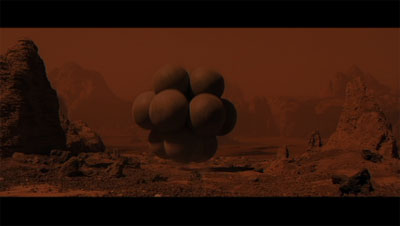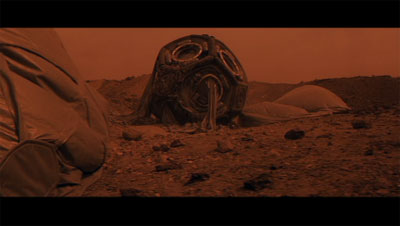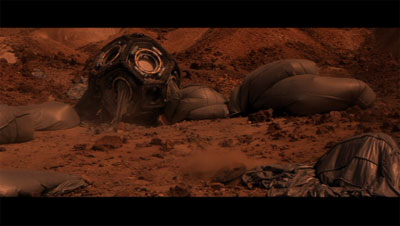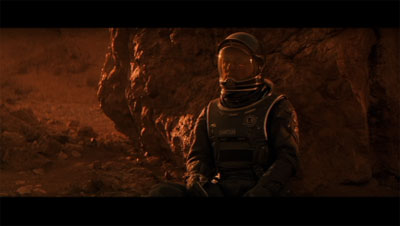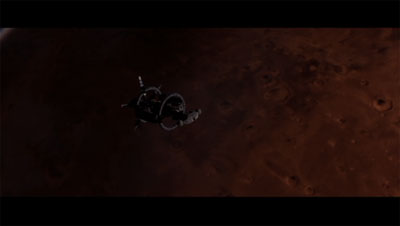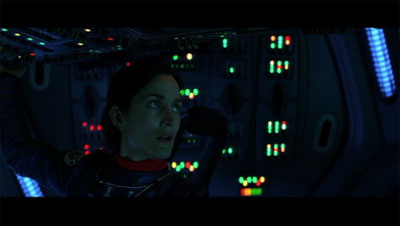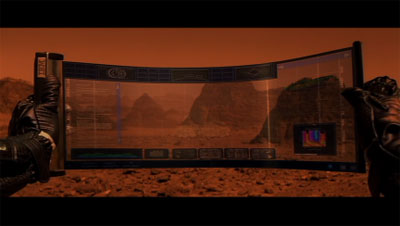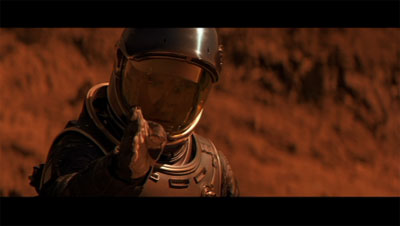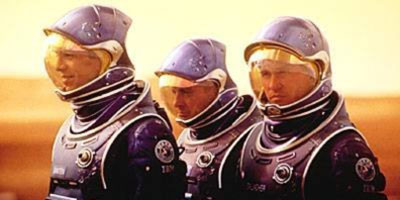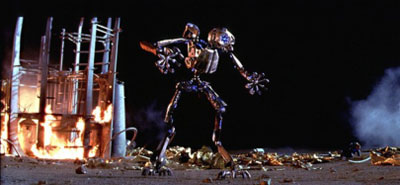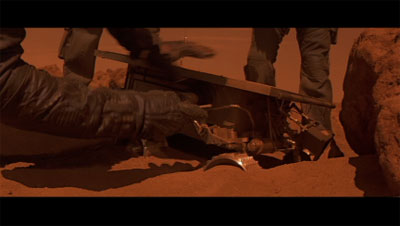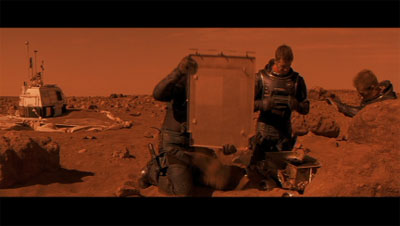|
|
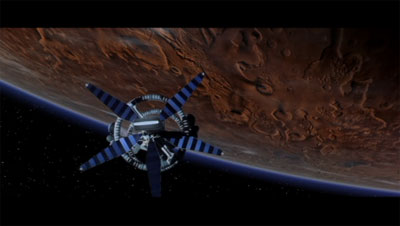 Red Planet was not a cinematic masterpiece, but it was the better of the two Mars-themed films released in 2000. (all photos credit: Warner Home Video) |
Planet Hollywood, part 2: Red Planet
by Dwayne Day
Monday, September 28, 2009

They don’t set movies on Mercury. Venus either. Or Jupiter or Saturn for that matter. Oh, certainly there are a few movies set on Venus. 2001 had the spaceship Discovery going to Jupiter, because Stanley Kubrick thought it would be too difficult to depict Saturn on the big screen. Doug Trumbull, who did the special effects for 2001, decided to set his own movie, Silent Running, at Saturn just to show it could be done (see “The green green grass of Earth”, The Space Review, March 2, 2009). There was also the barely tolerable Saturn 3 set at, well, Saturn—so that makes two for Saturn. And the ridiculously awful Event Horizon was set at Neptune, which provided a creepy backdrop for the haunted house in space story that had been done much better in numerous other movies. But you get the point: science fiction movies set in our own solar system don’t go to many planets.
They all go to Mars.
It is a cliché, but Mars captures the human imagination like no other planetary body except, maybe, the Moon. Other than Earth, it’s the planet that has been the subject of the most books and movies, a result of its ancient mystique and the fact that when you are outside on a very dark night, out in the middle of nowhere, where the city lights don’t spoil the night sky, Mars is so damn weird. A bright red spark that is both alluring and ominous.
| It is a cliché, but Mars captures the human imagination like no other planetary body except, maybe, the Moon. |
In 2000 there were two—count ‘em, two—Mars themed movies. They were the result of the plucky little Pathfinder rover achieving so much success in 1997. Hollywood suits read about how many hundreds of millions of web hits the rover got and decided that they wanted some of that action. So they greenlit Mission to Mars and Red Planet and only a few years later both movies debuted, and bombed.
Of course, movie tastes are personal, and plenty of people think that both of these films are awful and are not going to be convinced otherwise. But movie quality is partly relative. Neither film is awful—on a relative scale, there are plenty of other recent science fiction movies that are significantly worse than these two: the aforementioned Event Horizon, for example; or the so-bad-it-hurts Lost in Space, not to mention anything directed by Michael Bay. And that’s only counting the big budget science fiction movies and ignoring the movies that never aim that high, or that run on Saturday nights on the SyFy Channel (formerly the SciFi Channel, before some network suits did some lines of coke and then brainstormed a new name).
No, Mission to Mars and Red Planet, although not good, do have some redeeming qualities. Last week I discussed Mission to Mars. This week, I turn my attention to Red Planet, the better of the two.
Red Planet is set in the 2050s when Earth is so polluted that it is becoming unlivable. So the nations of the world have decided to nuke the water out of the polar ice caps on Mars and seed the planet with algae that can generate oxygen, with the eventual goal of sending humans to live on Mars. But something goes wrong—which it has to, or there would be no plot—and so Earth sends a spaceship with a six-person crew to Mars to figure out what’s happening. The crew is led by Commander Kate Bowman, with Lieutenant Ted Santen as her second in command. It also includes the brilliant and arrogant geneticist Quinn Burchenal, the inconsequential but pretty Chip Pettengill, the philosophical Dr. Bud Chantilas, and the ship’s repairman, or “space janitor,” Robby Gallagher. This is the kind of movie where everyone goes by their last names.
We learn all of this during an opening narration by Bowman while the crew is arriving at an Earth-orbiting space station prior to departing in Mars One.
Bowman, whose name was clearly a nod to the Discovery’s commander in 2001, was played by Carrie-Anne Moss, and if you don’t know who she is, that can be forgiven, for her career hasn’t really been existent in the past few years. But Moss was every fanboy’s fantasy in 1999 when she showed up in the opening scene of The Matrix wearing a skintight leather suit, hovering in midair, and kicking policemen in the face. Okay, to be more accurate, she was always far more cool than sexy. She seemed destined for superstardom, and surely the producers of Red Planet must have been hoping that this warrior chick from the future would help boost their film to the stratosphere.
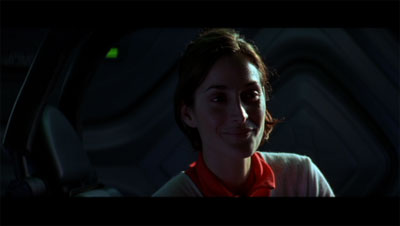 |
Burchenal was played by Tom Sizemore, who later commented that he was sober for the production and yet he saw no improvement in his acting performance compared to the movies he did while stoned. Pettengill was played by Simon Baker, with a short haircut. Baker has now become a heartthrob with flowing hair on CBS’ The Mentalist. Santen was played by Benjamin Bratt. Chantilas was played by the inestimable Terence Stamp who, even when he phones in his performance like he did on Red Planet, still manages to be pretty good.
But the lead is Gallagher, played by Val Kilmer. Kilmer at one time in the early 1990s was a major star, whom producers thought could bring in an audience with his name alone. But by Red Planet, Kilmer’s star was in eclipse. He’s at least decent in the role, and likeable. He plays the ship’s mechanic, in charge of fixing all of the systems. Hollywood producers often fear that the public will be turned off by characters who are depicted as brainiacs. Very few members of the audience, they think, are going to be scientists, so they try to make their leads into everyday kinda guys. Hence, Kilmer is a guy who fixes things. But this also proves vital to the plot.
| Hollywood producers often fear that the public will be turned off by characters who are depicted as brainiacs. Very few members of the audience, they think, are going to be scientists, so they try to make their leads into everyday kinda guys. |
There is one other member of the crew, a robot named AMEE. Someday, when somebody writes a history of computerized effects in movies, they will probably note the different trends that occurred as new pieces of software and artistic techniques became available. Robots and flames were big starting in the late 1990s. Admittedly, the man-sized AMEE looks good on screen, moving like a panther, crouching and then leaping.
We are also introduced to one of the film’s several contrivances. The mission borrowed AMEE from the Marines, which explains why the robot has a “military mode” whereby it can track and kill people. There’s an old saying about the theater that if you hang a gun on the wall in act one, you must use it by act three. AMEE is the equivalent of a howitzer, and we are all waiting for it to go boom. Why no one simply removed AMEE’s military software is never explained.
As if that foreshadowing is not enough, Gallagher also mentions that AMEE is equipped with a “helium nuclear fuel cell” the size of a beer can and capable of powering the robot for eight months.
One of the few things that Mission to Mars had going for it was the accuracy of its spaceships and habitats. Red Planet falls short in that regard. The Mars One ship is massive, stupid-looking, and just plain ugly. However, it has one redeeming quality: twin centrifuges. Such a setup makes a lot of sense. Spin one centrifuge and the entire ship wants to spin in the other direction. But spin two in opposite directions and they cancel each other out. (Incidentally, the technical advisors for 2001 had thought of this. The Discovery had a centrifuge, but also was supposed to have a flywheel spinning in the opposite direction to cancel out the momentum.)
For the first ten minutes or so of the film we are introduced to all of the characters, and it’s clear that it is a male-dominated ship. Even the sole female on the ship is macho (although she’s the only one we see in the shower). Red Planet oozes testosterone, or at least tries to. We see that Gallagher and Burchenal have built a still and are brewing industrial grade alcohol. When Bowman catches them, she proves that she is capable of holding her own liquor, even though she warns that it could blind them.
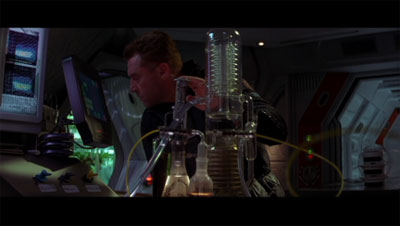 |
Whereas Mission to Mars went out of its way to show the three lead male characters as best buddies, and the husband and wife team as deeply in love, nobody in Red Planet seems to like each other. We see that there are some rivalries. Bowman doesn’t like Gallagher for some reason. Santen (Bratt) is constantly teasing Pettengill (Baker) about how successful he is with the ladies. And Burchenal (Sizemore) is just arrogant enough to be annoying, but not so much that we hate him. Chantilas (Stamp) is the resident spiritualist. Not everything can be explained by science, he says, and there is a higher power at work. Chantilas and Gallagher are apparently the only two people on the ship who actually like each other.
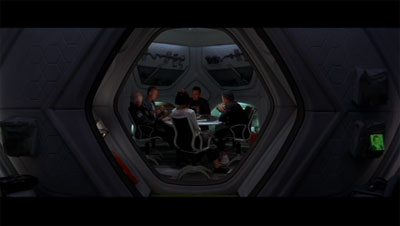 |
As they approach Mars something goes wrong. Of course something goes wrong. The writers thought that descending to Mars’ surface wasn’t tense enough, so they put the crew in peril. Rather than the silly meteorites of Mission to Mars, they chose a solar flare that wrecks the ship’s electronics, forcing most of the crew to prematurely abandon ship. The five men climb into the lander while Bowman stays aboard the crippled Mars One.
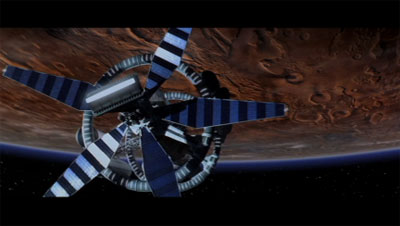 |
 |
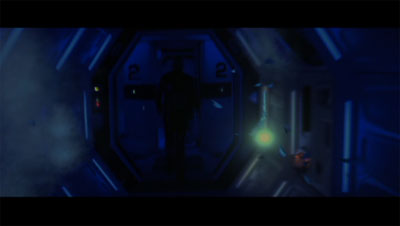 |
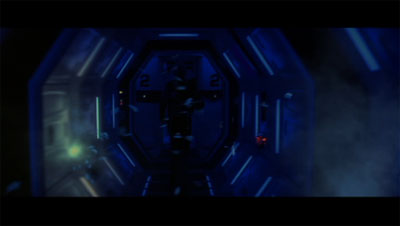 |
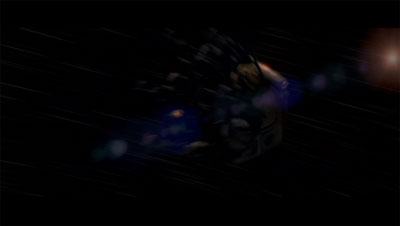 |
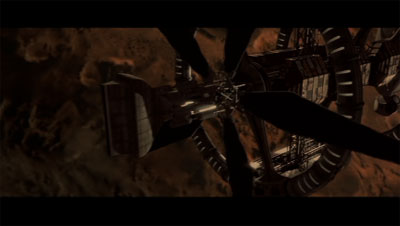 |
The lander doesn’t get high marks for accuracy. It lacks a heat shield, for starters, even though it is shown blazing a flaming trail through the atmosphere. It ends up off course from their habitat module, so they jettison the landing gear—along with AMEE—and descend under two rather small parachutes. What then follows is simultaneously stupid and awesome: the lander crew capsule deploys airbags to cushion its impact. It hits the ground hard, but then rolls off a cliff, tossing and turning the crew inside. All of this is clearly borrowed from the Mars Pathfinder mission.
During all the tumbling their radio is destroyed. More dramatically, Chantilas’ seat tears loose. He bashes against the side of the capsule. But eventually they stop rolling and they all climb out of their battered vehicle. Chantilas is mortally wounded and tells his crewmates to go on without him. Gallagher seems to be the only one to care about this as they abandon him to die.
In orbit, Bowman is struggling to save her ship and then to repair it. Eventually she gets the systems back online and realizes that she cannot stay at Mars. She has to head back to Earth.
The four survivors on Mars, Gallagher (Kilmer), Santen (Bratt), Pettengill (Baker) and Burchenal (Sizemore), all set out to find their habitat module, which was landed long before they arrive. They have to navigate on Mars without external assistance. They do have one of the film’s clever technological touches: flexible display screens that can be rolled up like a piece of paper. They manage to figure out that some rocks on the horizon are in one of their maps, although the image is reversed and they have to do some basic calculations. This prompts one of the film’s better lines from Kilmer: “This is it, the moment they all told us about in high school where one day algebra would save our lives.”
The men’s bickering continues as they romp across Mars’ surface. Burchenal comments that the surface is supposed to be covered with the algae that had been dropped from orbit. Where is it? Burchenal asks.
Eventually they reach the site of their habitation module only to discover it blown to smithereens. It’s in millions of pieces. Burchenal notes that it looks like it has been shredded, not simply blown up. But it doesn’t matter; the men are nearly out of air.
| This prompts one of the film’s better lines from Kilmer: “This is it, the moment they all told us about in high school where one day algebra would save our lives.” |
Santen and Pettengill wander off for some reason and get into an argument. Pettengill shoves the other man who slips and falls off a cliff. The staging of the scene is pretty good and it’s clear that Pettengill never intended to kill his commander. It was an accident, but it sets up a plot point for later in the movie.
Back at the destroyed hab, the men are running out of oxygen and Burchenal tells Gallagher about how agonizing their deaths will be. Finally, Gallagher, struggling for air, opens his helmet only to discover a breathable atmosphere on Mars. The three men are saved.
As the sun goes down they set the remains of the habitat on fire for warmth. But AMEE shows up, in “military mode” of course, and attacks them. Even though the powerful robot could easily kill them all, it decides to play war games. It wounds Burchenal and then takes off to stalk them over the surface of Mars.
Meanwhile, in orbit, Bowman has fixed the ship, but she has a limited amount of time to fire the engines and head back to Earth. She has photographed the habitation module wreckage. Mission control informs her that the landing crew must be dead and she should head back alone.
All this time the men have been unable to contact Mars One. But they come up with a plan: find the Mars Pathfinder rover and use its radio to communicate with their spaceship. After more walking across the surface they locate the tiny rover and remove its radio and space mechanic Gallagher proves that he can fix anything. They manage to get in touch with Bowman on Mars One. (The rover and its lander vehicle both look virtually identical to the real thing, so the moviemakers clearly wanted to connect with the audience’s familiarity with Pathfinder.)
Mission control back on Earth comes up with a plan. The men are to head to the site of a failed Russian sample return spacecraft, fix it, and ride it to orbit. (In yet another dig at the Russians, who never come across very well in American sci-fi, Bowman informs them that the spacecraft’s designer has been located operating a diner in Brooklyn.) Once again they set out across the surface.
page 2: dueling Mars >>
|
|
